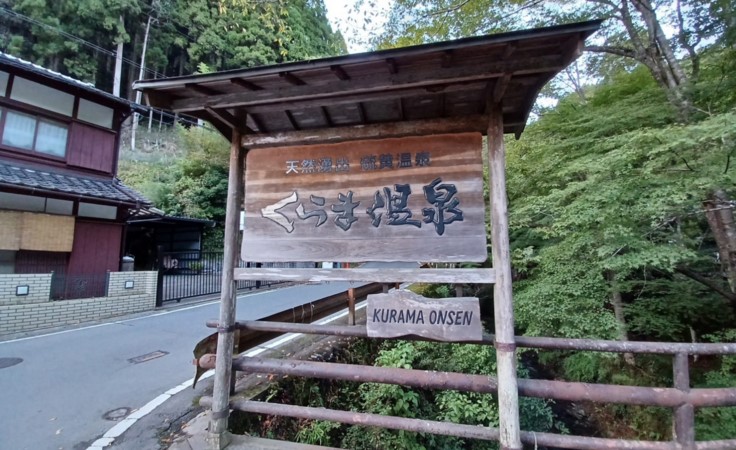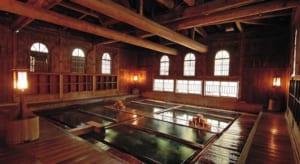Kurama Onsen: Kyoto’s Healing Waters
Kurama Hot Spring Guide

Tucked away in the mountains just north of Kyoto, Kurama Onsen is one of those places where Japan’s natural beauty and traditional culture come together in an unexpected way. For centuries, Kurama has been a site of spiritual importance, rumored to be where mythical creatures once trained monks in martial arts. Today, the onsen here draws visitors with its mineral-rich hot springs, open-air baths, and the calming scenery of cedar forests.
Unlike many onsen, Kurama stands out as welcoming to all, even those with tattoos, making it a rare find for international visitors looking for an inclusive experience in Japan’s onsen culture. Historic temples and nice hiking trails also round up the attractions in the vicinity, making the area a perfect choice for a memorable escape just a short trip from Kyoto’s city center.
What is Kurama Onsen?

Kurama Onsen (鞍馬温泉) is a beloved hot spring located in the forested hills of northern Kyoto, where visitors can step back in time and experience a side of Japan that feels worlds away from the city. With roots in the spiritual traditions of the area, Kurama Onsen has become a go-to destination for those seeking relaxation and a closer connection to nature.
The history of Kurama Onsen dates back to ancient times, with Kurama itself long known as a sacred place tied to mountain asceticism and local legends of tengu, or mystical creatures that are said to inhabit the mountains.

Over the years, the area gained popularity for its healing hot springs, which flow naturally from the earth, drawing both locals and travelers in search of rejuvenation. Known for its mildly alkaline waters, the onsen is believed to have therapeutic properties that help relieve fatigue and soothe aching muscles. Kurama Onsen today offers both indoor and outdoor baths, the latter providing panoramic views of lush forests and surrounding mountains.
The Revival of Kurama Onsen

Kurama Onsen has weathered multiple setbacks in recent years. Alongside the challenges brought on by the coronavirus pandemic, a series of landslides damaged the main Eizan Electric Railway line that connects Kyoto to Kurama, cutting off a key route for visitors. With both natural and public health obstacles affecting access and visitor numbers, Kurama Onsen fell into a challenging decline and eventually needed to close for renovations.
However, with strong community support and a dedicated crowdfunding campaign, the onsen has made a remarkable comeback. Local efforts restored the facilities while preserving the authentic charm that Kurama is known for. From November 1st, the onsen will be once again welcoming visitors with renewed vigor, drawing guests eager to experience its peaceful, forested retreat in the Kyoto mountains.
Does Kurama Onsen allow tattoos?
One of Kurama Onsen’s most appealing qualities for international visitors is its open-minded approach to tattoos. In Japan, many onsen still prohibit individuals with tattoos due to longstanding cultural associations, but Kurama Onsen is refreshingly inclusive, welcoming tattooed guests without restrictions. This progressive policy makes it stand out among traditional onsen and has cemented its reputation as a top choice for travelers from abroad who want to enjoy Japan’s onsen culture.
This is why, when many ask, “Which onsen is best for foreigners in Japan?” Kurama Onsen ranks high on the list due to its tattoo-friendly stance and easygoing atmosphere.
What to do at Kurama Onsen

Here’s a quick list of things you can enjoy while visiting:
- Outdoor Rotenburo Bath: Soak in the open-air bath surrounded by forested mountains for a truly scenic experience.
- Indoor Baths: Enjoy the indoor baths with the same mineral-rich, mildly alkaline waters known for easing muscle aches and fatigue.
- Onsen Dining: After a refreshing dip, try traditional Japanese dishes in the onsen’s restaurant, featuring local ingredients and seasonal flavors.
- Suitable for a Day Trip: One of the best things of Kurama Onsen is that you don’t need to book an overnight stay to enjoy these baths! You can simply spend the day or a nice afternoon after exploring the surroundings and maybe end the experience with a delicious meal.

- Accommodation: If you really want the complete onsen experience, spend the night at Kurama Onsen’s ryokan, where you can enjoy private access to the baths and a traditional Japanese-style room.
- Stroll in Nature: Take advantage of Kurama’s lush surroundings with a nature walk. A quick hike around the onsen area reveals the charm of Kyoto’s mountainous landscapes.
By the way, if you’re one of those who wonder if you need to wash yourself after onsen, allow us to clarify: In Japan, it’s not customary to rinse off after soaking, as the mineral-rich water is believed to have lingering benefits for the skin. So, you can simply dry off and carry those relaxing effects with you.
Check also: Japanese Onsen Etiquette: Dos and Don’ts
How do I go to Kurama Onsen?
From Kyoto Station, take the local buses to Demachiyanagi Station bus stop and switch to the Eizan Main Line from Demachiyanagi Station to enjoy a scenic ride up into the mountains until Kurama Station. From that point, it’s just a short 12-min walk.
Map:
Address:
520 Kuramahonmachi, Sakyo Ward, Kyoto, 601-1111
Hours:
Kurama Onsen Bathing:
Open from 11:00 AM to 8:00 PM (last admission at 7:30 PM).
Dining Area:
- Lunch: 12:00 PM to 3:00 PM (last order at 2:30 PM)
- Dinner: 5:00 PM to 8:00 PM (last order at 7:30 PM)
- From 3:00 PM to 5:00 PM, the dining area operates as a café.
Price:
Indoor bath, Open-air bath, Sauna
- Adult (for ages 13 and above): 2,500 yen (weekday) 2,700 yen (weekend)
- For ages 3~12: 1,300 yen
- For children under 2 years old: Free
Open-air bath
- Adult (for ages 13 and above): 1,400 yen (weekday) / 1,600 yen (weekend)
- For ages 3~12: 700 yen
- For children under 2 years old: Free
Open-air bath coupon book (10 tickets): 12,000 yen
Smoking:
Allowed in restricted areas
Official Website:
Tourist Reviews of Kurama Onsen
Kurama Onsen consistently receives high ratings across multiple review platforms. On Google, it holds a solid 4.3/5 from over 1,200 reviews, reflecting its popularity among locals and visitors. TripAdvisor users give it an even higher rating of 4.5/5, placing it third among 13 onsen ryokans in Kyoto, while Yelp users rate it at 4.7/5. These ratings collectively highlight the onsen’s appeal as a unique, authentic experience just a short trip from Kyoto.
One reviewer on TripAdvisor captures the value of the onsen for those on tight schedules, saying,
“If you don’t have time to visit Hakone or another onsen town while you’re in Japan, this is a great way to get the experience for a couple hours not far from Kyoto. Recent reports say that they allow tattoos too so that is a big plus for many foreigners. The town where it is located in Kyoto is really quaint and lovely and it is easy to get to by train but a walk uphill for about 10 minutes to the facility. Great value, inexpensive and good for families. Highly recommended if you’re short on time and you want a very authentic experience of a Japanese onsen in nature.”
– from Tripadvisor
Another review on Yelp reflects the memorable experience of a first-time visitor:
“This was my first hot spring experience and I loved it! Our group did come to the onsen around closing time but we still got our money’s worth when we got to the bath areas. While we weren’t greeted extravagantly, our group agreed that we felt rejuvenated after taking a dip in the bath. You pay the entrance fee when you get there (at a vending machine). The facilities require you to place your items in a locker, which require a 100 yen deposit. You will get it back when you exit the facilities. And they do require you to take off your clothes before entering the baths. It may seem strange if you’re not used to showing off skin in public, but everyone’s doing it so don’t feel ashamed. I recommend this place to everyone if they are visiting the Kurama area.”
– from Yelp.com
The reviewer appreciated the straightforward entry process and felt comfortable with the onsen etiquette, a reassuring detail for newcomers.
Overall, Kurama Onsen is highly rated for its accessibility, serene natural setting, and welcoming atmosphere. Whether for a short visit or a longer stay, it offers a taste of authentic Japanese hot spring culture close to Kyoto.
Tourist Attractions Near Kurama Onsen
The surrounding area of Kurama Onsen is filled with cultural and natural sights that add depth to any visit:
1. Kurama dera
Located on the slopes of Mount Kurama, Kurama dera (鞍馬寺) is a Buddhist Temple surrounded by legends. Founded over a thousand years ago, the temple is closely linked to the stories of tengu—mythical, bird-like creatures believed to protect the area and guide ascetic monks. The temple complex, with its striking red buildings, offers sweeping views of the valley below and is surrounded by dense forest, making it a serene escape.
Visitors reach Kurama dera by climbing a forested path from Kurama Station or by taking a short cable car ride up part of the mountain. This journey through towering cedar trees is an experience in itself, and the temple grounds feature various statues, shrines, and sacred sites.
Official Website: https://www.kuramadera.or.jp/
2. Kifune Jinja
A short hike or a quick train ride from Kurama Onsen brings you to Kifune Jinja (貴船神社), a revered Shinto shrine dedicated to the god of water and rain. Nestled along a picturesque mountain river, Kifune Jinja is known for its atmospheric charm and red lantern-lined pathways that create a stunning view, particularly during the spring and autumn seasons. The shrine complex is divided into three main areas—each with its own unique ambiance and sense of tranquility.
One of the shrine’s popular features is its omikuji, or fortune-telling paper strips, which reveal your fortune only when dipped in the shrine’s sacred water. This water-related ritual makes Kifune Jinja a meaningful stop for those seeking good fortune or blessings, especially in matters related to relationships and travel. After visiting, many travelers enjoy a meal at one of the riverside restaurants in Kibune Village, where you can dine on platforms suspended above the gently flowing stream—a refreshing way to experience the shrine’s peaceful surroundings.
More info: Kifune Shrine: New Travel Destination in Kyoto
3. Mount Kurama
For hiking enthusiasts, Mount Kurama (鞍馬山) is an essential stop. This sacred mountain, which forms the backdrop for Kurama Onsen and Kuramadera, is a place of mystery and natural beauty, known for its dense forests, rocky trails, and historical sites scattered along the path. A hike through Mount Kurama’s trails is both invigorating and culturally enriching, with ancient temples, hidden statues, and sacred spots that dot the landscape.
The hike from Kurama to Kibune is a popular route, taking visitors along a 2-3 hour trail that winds through the mountain’s serene forest. This path is especially breathtaking in the autumn, when the foliage transforms the area into a vibrant display of reds and golds. Mount Kurama also offers numerous scenic viewpoints where hikers can pause to admire the views across the Kyoto countryside. The mountain’s mystical reputation and peaceful trails make it a favorite spot for those seeking both a physical challenge and a journey into the heart of Japanese folklore.
▽Subscribe to our free news magazine!▽
For more information about Onsen and traveling in Japan, check these articles below, too!
▽Related Articles▽
▼Editor’s Picks▼
Written by
Photographer, journalist, and avid urban cyclist, making sense of Japan since 2017. I was born in Caracas and lived for 14 years in Barcelona before moving to Tokyo. Currently working towards my goal of visiting every prefecture in Japan, I hope to share with readers the everlasting joy of discovery and the neverending urge to keep exploring.


















